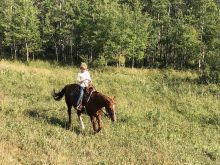As a beef nutritionist, I haven’t heard about many fatal cow bloat cases over the last 10 years, but of the few I’m aware of, it seems it takes only a few things to come together to make bloat deadly. From talking to experienced beef producers, I am also aware that the risk of annual bloat can be quickly defused if common sense prevails. Some preventative steps can be taken in early spring before letting cows out onto lush green pasture.
Most of these measures are simple and yet effective against bloat. That’s because, the development of bloat lends itself to simple ruminant biology. The rumen microbes ferment a mouthful of pasture forage into essential nutrients which are used by the cow to perform its vital functions, nurse a calf and get ready for rebreeding. As part of this process, gases such as carbon dioxide and methane subtly distend the rumen, yet trigger ruminal nerves which cause gas expulsion during “cud chewing.” Unfortunately, bloat develops when for some reason the same rumen cannot release this gas, which may accumulate to deadly asphyxiation.
There are two types of bloat that can be fatal to beef cows on pasture. The first type is “free-gas” bloat which is straight accumulation of trapped gas in the rumen. It occurs in about 10 per cent of all pasture bloat cases and is thought to be predominant among chronic bloaters. The other type of bloat is known as “frothy bloat,” which encompasses most problems on pasture.
Read Also

Harvest wraps up and fall work begins
At the Eppich famly ranch in western Saskatchewan, the fall harvest was successful with few breakdowns, cows and calves have been sorted and a new tractor has arrived
Frothy bloat occurs when the rate of forage consumption and digestion is so rapid that fermentation gases mix with the rumen fluid. Natural gas release is slow, because gases are trapped inside small emulsified bubbles. This gaseous froth often interferes with the rumen nerve receptors that open the esophagus for gas expulsion.
Higher risk with alfalfa
Cattle are often susceptible to frothy bloat when grazing lush alfalfa pastures compared to other types of sprouting legumes and grasses. This is due to alfalfa’s (1) low fibre content that allow greater consumption in a short period, (2) a rumen digestion rate that is up to 10 times greater than most grasses; producing lots of carbon dioxide and methane, and (3) a high level of soluble protein that increases the thickness of rumen fluid, which can easily trap gas bubbles and prevent their natural expulsion.
The potential for frothy bloat is greatest when alfalfa pastures are in lush vegetative to early stages of growth. As the grazing season progress, like other pasture plants alfalfa matures as it enters its bloom stage. Fibre levels in its stems increase substantially and soluble protein levels in its leaves decrease. This natural maturation of alfalfa plants lessens overall bloat risk.
There are a couple of ways to treat frothy bloat that pops up in a beef cow herd grazing lush pasture. For example, the Canadian Food Inspection Agency lists Poloxalene (Bloat Guard) to be fed at 1.0 g per 45.36 kg of bodyweight for moderate bloat cases and 2.0 g per 45.36 kg per 45.36 kg bodyweight for severe ones.
Prevention
However, I talked to a couple of beef producers that graze pasture in the spring and they believe that prevention of frothy bloat is the best medicine in the first place.
- The first producer has a 300 cow-calf operation. He and his wife put out barley straw bales on the first few acres of alfalfa-grass pastures where the cattle are initially released. The idea is to let their cows fill up on straw. They keep putting out bales for the first couple of weeks of the pasture season. It also seems having access to salt blocks and loose mineral on the same pasture reduces the incidence of bloat.
- The second producer has a 150 cow-calf operation. He calves his cows on grass pastures and practises rotational grazing. His cows graze mostly grass stands for the first few weeks of spring, because there aren’t many alfalfa fields to be grazed. Most of his cattle move onto predominantly alfalfa fields in the midsummer and by then pastures have matured.
These are two great testimonials that effectively control bloat in beef cows grazing early spring pastures. Their experiences are of timeless value. While its risk cannot be totally eliminated, frothy bloat can be substantially reduced with a sound preventative action plan, before the first cow steps foot onto lush green fields.
















